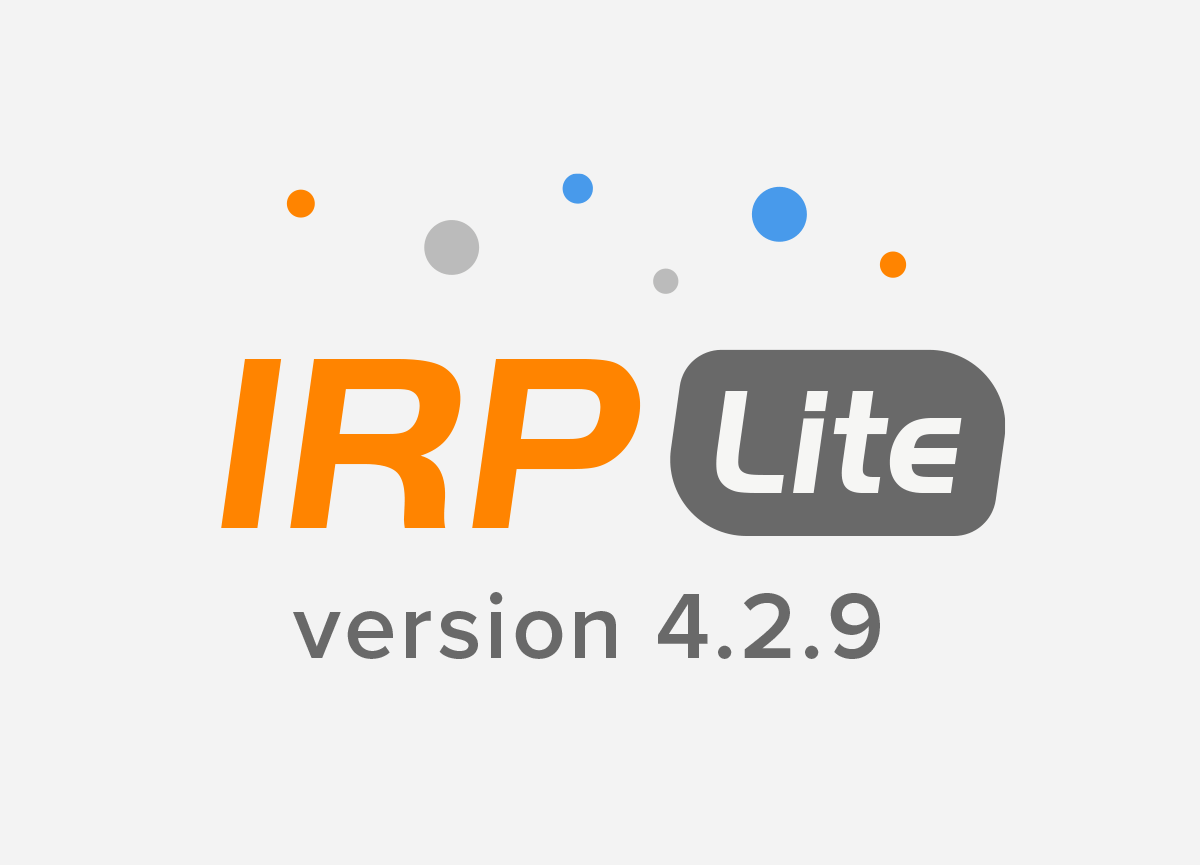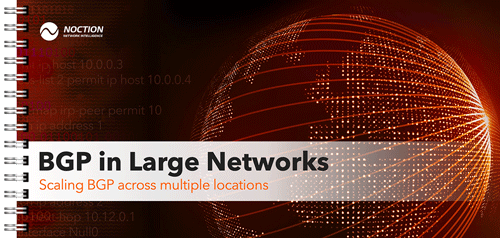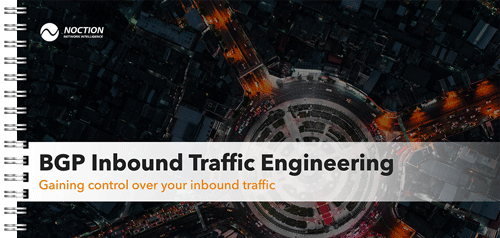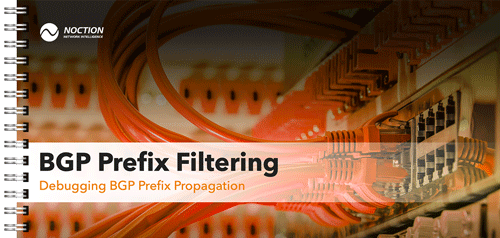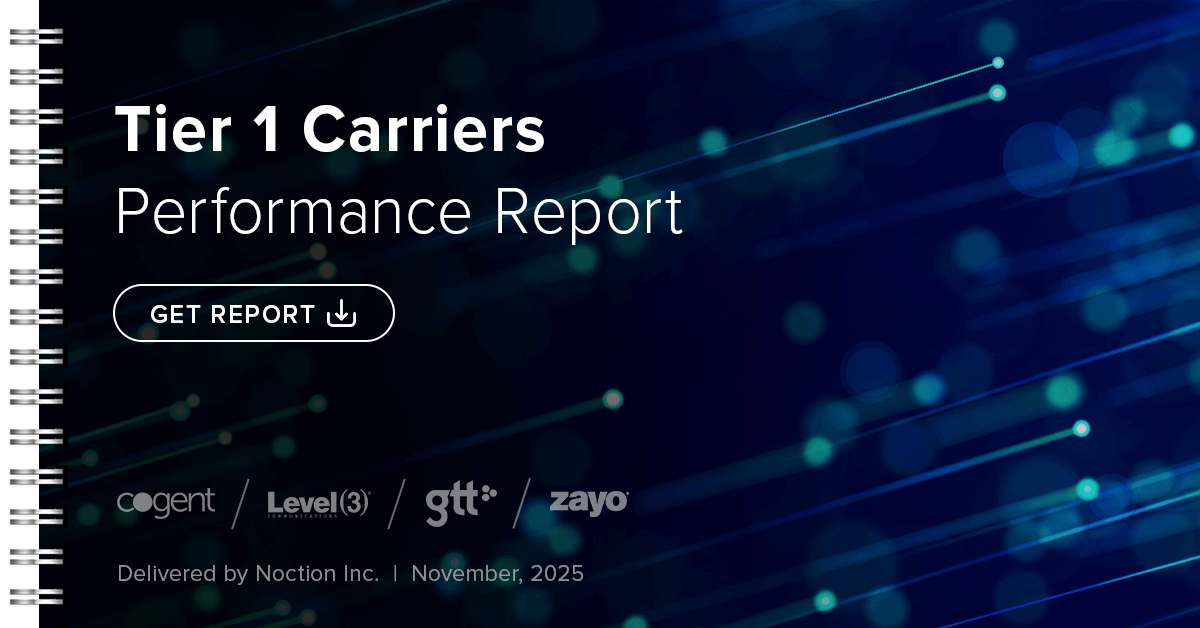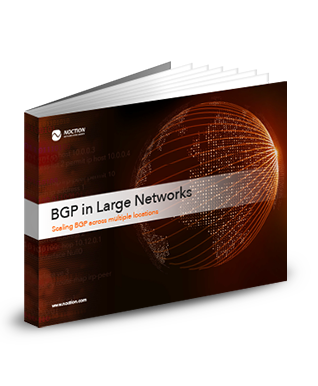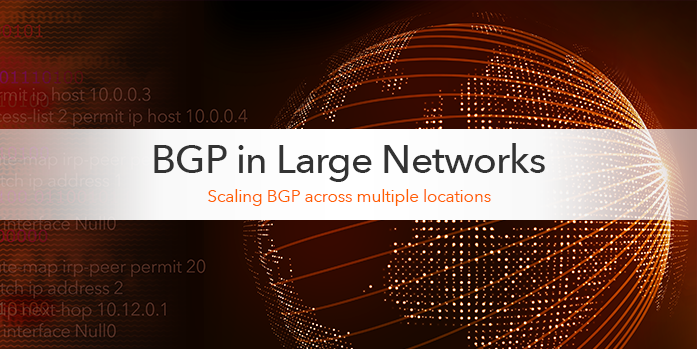
Implementing BGP has many benefits: it becomes possible to use multiple ISPs at the same time, augment transit service from an ISP with peering with other networks and isolation from problems in ISP networks. If, when using multiple ISPs, one ISP goes down, most of the time BGP automatically reroutes traffic over the other ISP(s). And if an ISP doesn’t deliver the desired performance, connecting to another one is just a matter of getting the physical connection in place and a few lines in a router configuration—no renumbering of servers and other systems necessary.
Usually, when an organization implements its first BGP configuration, they do this by putting two BGP routers at the edge of their network. Of course just one BGP router would also work, but the second one is required in case the first one fails. The existing internal network is usually left running as before, typically using OSPF routing. This makes for a very simple BGP setup, where each router has the requisite filters to make sure only the network’s own IP address block(s) are advertised to the outside world over eBGP (external BGP), an all of one iBGP (internal BGP) session between the two BGP routers. Adding a third and maybe even a fourth router in the same location doesn’t change that picture very much.
However, things do get more complex in networks that span multiple locations and have routers that communicate with other networks over eBGP in more than one location. In those networks, it’s important to think about the following:
- Using iBGP with loopback addresses
- Making sure all routers know next hop and loopback addresses
- Whether to use route reflectors rather than an iBGP full mesh
- Where to originate prefixes
- Where and how to filter announcements
iBGP with loopback addresses
When a network only has two BGP routers and those routers are connected using a connection that is very unlikely to go down, the most straightforward iBGP setup is to simply configure it much the same as an eBGP session: by using the interface address of the other router as the neighbor address, as displayed in Figure 1.

Figure 1: an iBGP session using interface addresses in a small network.
However, in a larger network the BGP routers typically don’t sit right next to each other so it can simply be assumed that the link between them never goes down. Suppose that in the network in Figure 2 the link between routers 1 and 3 goes down. This means that address 10.0.1.1 on router 1 and address 10.0.1.2 on router 3 are no longer reachable, so all iBGP sessions to and from those addresses go down, even though routers 1 and 3 can still communicate by going through routers 2 and 4.
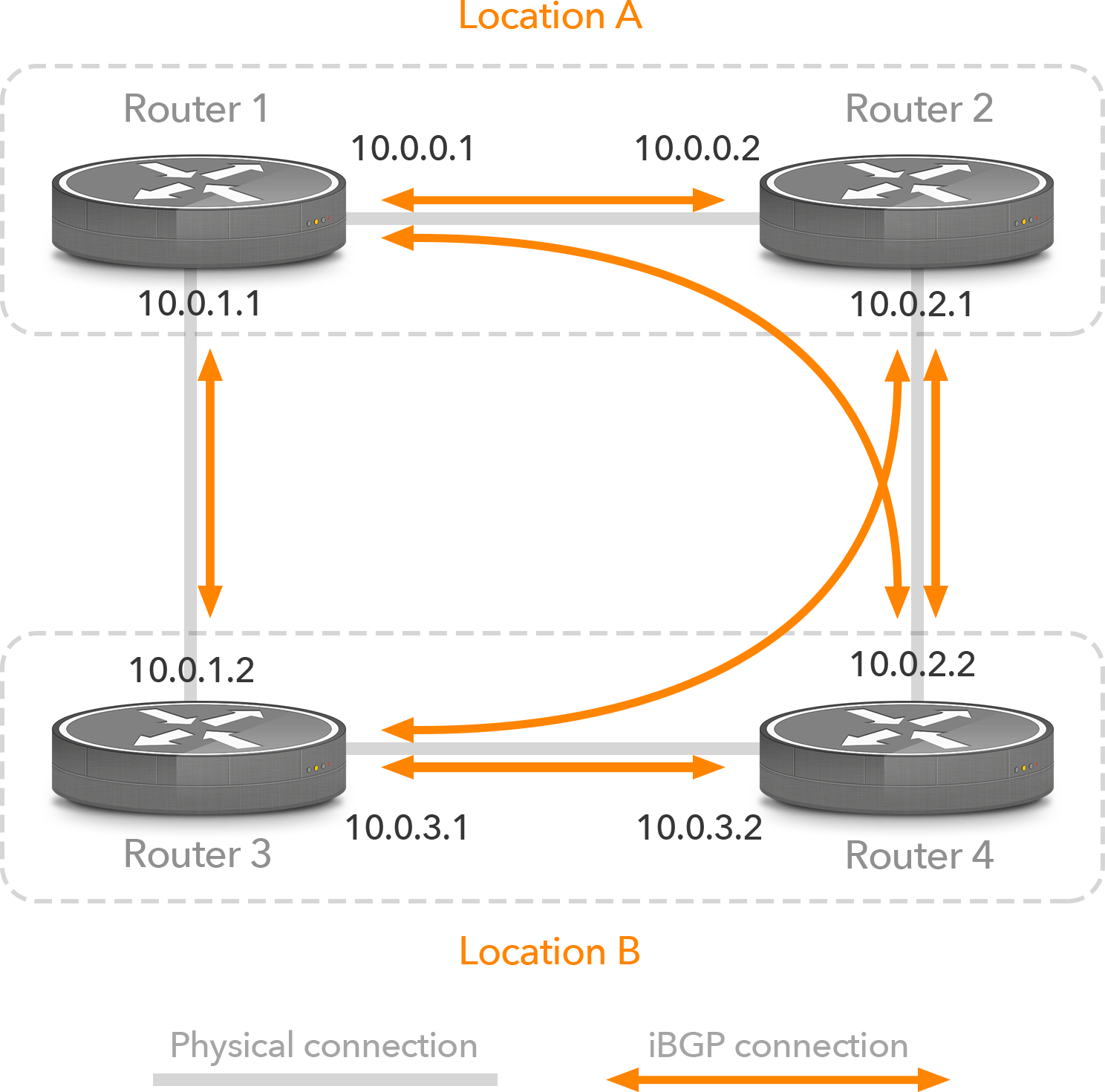
Figure 2: iBGP sessions using interface addresses in a larger network
By using loopback addresses as the source and destination of iBGP sessions, there is no longer any dependency on a particular interface of a router. This may seem strange, as hosts always use the loopback addresses 127.0.0.1 (IPv4) and ::1 (IPv6). On a host, the loopback address is used for applications to talk to other applications running on the local system. However, on routers, loopback interfaces have a regular address, which can be used for management and control communication.
The difference between a loopback address and the address configured on a regular interface is that the loopback address is always up, while an interface address becomes unreachable when the interface it’s configured on goes down. Because loopback interfaces don’t connect to anything, it’s possible to configure them with an individual /32 (IPv4) or /128 (IPv6) address. However, in order for remote systems to reach a loopback address, it must be injected into an interior routing protocol such as OSPF.
So in Figure 3, if the link between routers 1 and 3 goes down, the iBGP session (and all data packets between routers 1 and 3) will flow through routers 2 and 4. When the link between routers 1 and 3 comes back up and then the link between routers 2 and 4 goes down, the iBGP packets as well as data packets between routers 1 and 3 fill flow over the direct link, and now the communication between routers 2 and 4 will also make use of that path.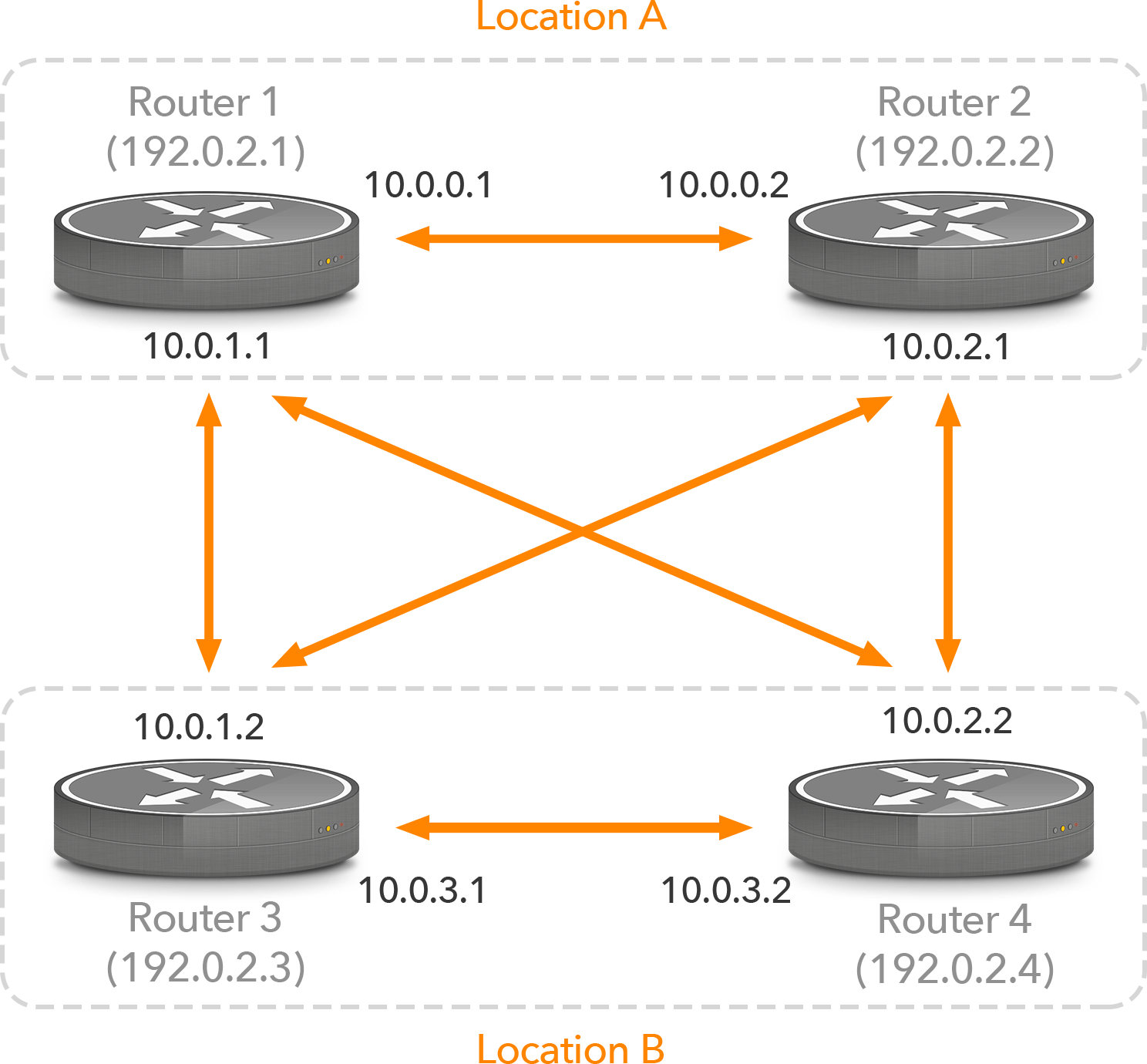
Figure 3: iBGP sessions using loopback addresses
On a Cisco router, the configuration to use iBGP between loopback addresses would look like this:
interface Loopback0
ip address 192.0.2.1 255.255.255.255
!
router bgp 65000
neighbor ibgp peer-group
neighbor ibgp remote-as 65000
neighbor ibgp update-source Loopback0
neighbor 192.0.2.2 peer-group ibgp
neighbor 192.0.2.3 peer-group ibgp
neighbor 192.0.2.4 peer-group ibgp
!
The loopback interface gets IP address 192.0.2.1/32. The peergroup ibgp is configured to use the same AS number for the remote routers as the local AS number; this makes the BGP sessions in question iBGP sessions. The update-source line makes sure the router will use the address of the loopback interface as the source address in outgoing BGP updates. Three neighbors inherit the settings configured for the peergroup ibgp.
Propagating loopback and next hop addresses
The configuration above needs one additional thing: other routers in the network need to know where to send their packets for each router’s loopback address in order to set up their iBGP sessions. This is accomplished by running an internal routing protocol such as OSPF and then redistributing those loopback addresses into that routing protocol.
eBGP, on the other hand, normally runs between addresses on opposite sides of a shared subnet, and as such each router knows where to send packets addressed to the other by virtue of being connected to that same subnet. However, there is a complication: when a prefix learned over eBGP is propagated over iBGP, its next hop address isn’t changed.
For instance, consider Figure 4. Router 1 and the ISP router share the 172.31.0.x subnet, so router 1 can reach the ISP router’s address 172.31.0.1 without the help from an interior routing protocol. The prefixes router 1 receives from the ISP router then have 172.31.0.1 as their next hop address, which obviously doesn’t pose any issues for router 1. However, when router 1 propagates these prefixes to router 2 over iBGP, they’ll still have next hop address 172.31.0.1, and router 2 doesn’t have a route to that address.
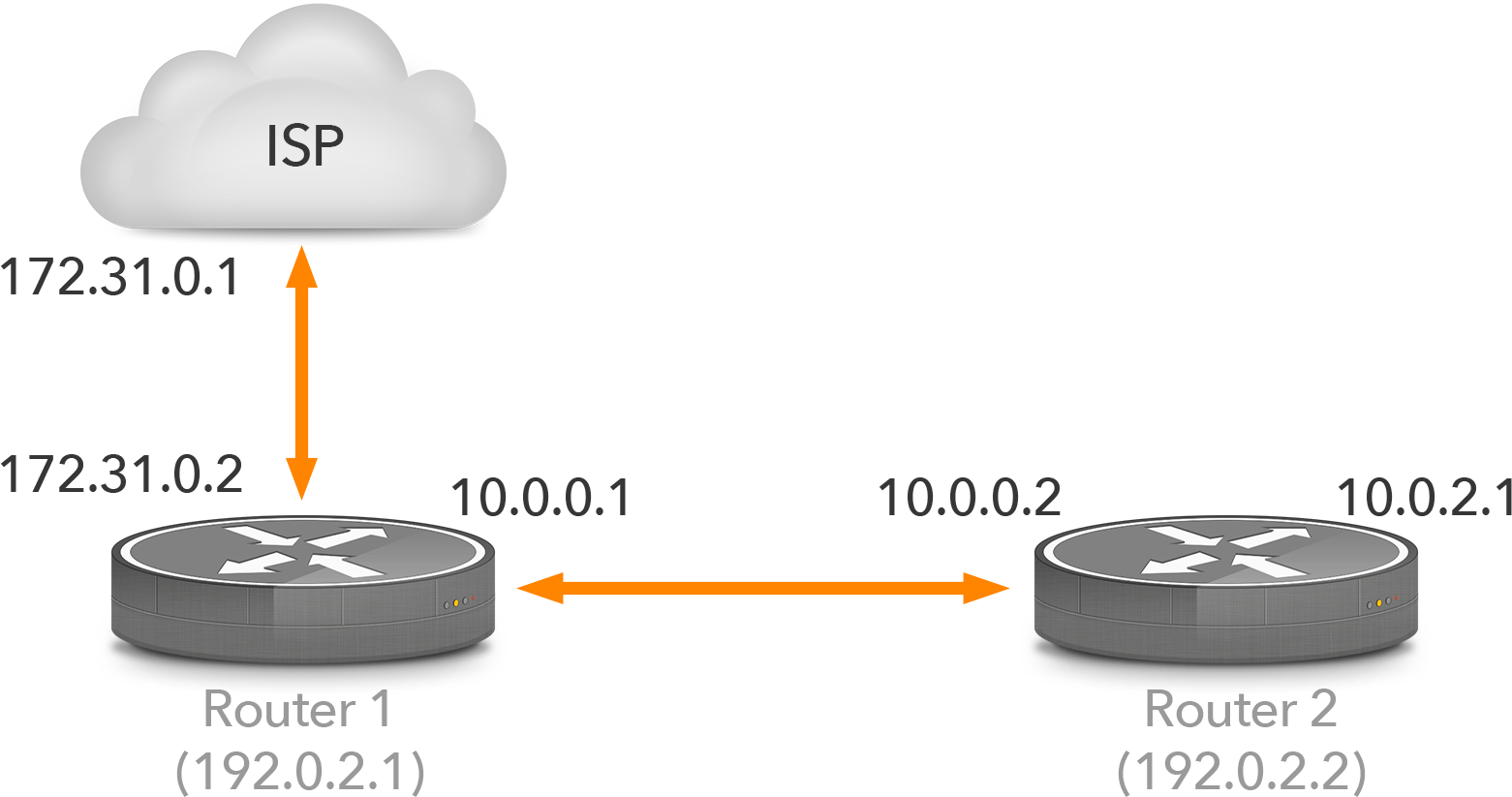
Figure 4: eBGP and iBGP
There are two ways to solve this. The first option is to configure next-hop-self on router 1 for the iBGP session towards router 2. Router 1 will then replace the next hop address with its own address (10.0.0.1 in this case) so router 2 doesn’t need to know where the address of the ISP router goes. The other option is to redistribute the subnet used between the ISP router and router 1 into the interior routing protocol. Router 2 then knows where packets for 172.31.0.1 go, and thus, where packets for destinations with 172.31.0.1 as their next hop address go.
| Note: as networks grow larger and more complex, using next-hop-self becomes less preferred because it can further complicate already complex networks, for instance, by making traffic flow through a route reflector unnecessarily. So in general, it’s better to redistribute next hop addresses into the interior routing protocol. |
Assuming the routers already run OSPF, the following configuration will redistribute connected subnets in OSPF:
router ospf 1
redistribute connected subnets
!
By default, redistributed routes appear in OSPF as “external type 2” (E2).
Route reflectors
To avoid loops, BGP routers are only allowed to learn prefixes over iBGP from the router that advertises them or learned them over eBGP. As a result, every BGP router must have an iBGP session with every other BGP router in the network. In other words: there must be a full mesh of iBGP sessions. In networks with hundreds of routers, maintaining so many iBGP sessions can become a problem. However, long before the router’s CPUs get overloaded with iBGP processing, the iBGP full mesh requirement becomes problematic when adding new routers, as this requires configuring all existing routers with a new iBGP session.
There are two ways to avoid the iBGP full mesh requirement: confederations and route reflectors. Confederations split an Autonomous System (AS) into sub-ASes where the full mesh requirement only applies within each sub-AS. However, confederations have fallen out of use. Route reflectors propagate information learned over one iBGP session over other iBGP sessions, implementing additional logic to make sure there can’t be any loops. In a network with route reflectors, there are three types of BGP routers:
- Route reflectors
- Route reflector clients
- Non-client peers
To further complicate matters, there can be a hierarchy of route reflectors, where a route reflector is in turn a client of another route reflector. However, the configuration is very straightforward:
router bgp 65000
neighbor ibgp peer-group
neighbor ibgp remote-as 65000
neighbor ibgp update-source Loopback0
neighbor rrclients peer-group
neighbor rrclients remote-as 65000
neighbor rrclients update-source Loopback0
neighbor rrclients route-reflector-client
neighbor 192.0.2.2 peer-group rrclients
neighbor 192.0.2.3 peer-group rrclients
neighbor 192.0.2.4 peer-group ibgp
neighbor 192.0.2.5 peer-group ibgp
!
In this configuration, neighbors 192.0.2.2 and 192.0.2.3 are members of the rrclients peergroup, and thus the route-reflector-client statement applies to them, making them route reflector clients. Neighbor 192.0.2.4 and 192.0.2.5 are in the regular ibgp peergroup and are not route reflector clients. They may be route reflectors themselves, or they can be non-client peers.
| Note: the route-reflector-client keyword on an iBGP session makes the router on the other end of that iBGP session a route reflector client. The client itself doesn’t know that it’s a route reflector client and doesn’t change its behavior. |
In this setup, the iBGP full mesh requirement still applies to non-clients 192.0.2.4 and 192.0.2.5, so these still need to have an iBGP session towards each other. The route reflector will propagate iBGP information from the other iBGP routers to 192.0.2.2 and 192.0.2.3, so these routers don’t require iBGP sessions with any other BGP routers. However, it’s fine for these routers to have additional iBGP sessions, it’s just that they don’t need to have iBGP sessions to the rest of the BGP routers anymore. In practice, each BGP router should be served by at least two route servers, so when something goes wrong with one route server, the clients don’t get disconnected from the iBGP cloud.
It’s important to give some consideration to the placement of route reflectors. Suppose that in the network in Figure 3 routers 1 and 2 are route reflectors. Router 3 now wants to send packets to a destination that is reachable over eBGP through both router 1 and router 4. Router 4 is in the same location as router 3, so under normal circumstances, the shorter internal path towards router 4 would make the path through router 4 more preferred, assuming that the local preference, AS path length and MED are all the same. However, to router 1, its own external path is preferred over the path through router 4. So in its capacity as a route reflector, router 1 will propagate its own external path to router 3, effectively hiding the path through router 4. And as a result the packets will travel a longer path across the internal network than would be the case without route reflectors or the case where router 3 has an iBGP session to a local route reflector.
| Note: as such, it’s best to have at least one route reflector be local to the route reflector clients and/or have route reflectors in all locations that have external connectivity. |
Where to originate prefixes
In a network with just two BGP routers, both BGP routers announce all prefixes. They also originate all prefixes. To originate a prefix means that a BGP router is configured to inject a prefix into BGP. It will then announce that prefix over all its iBGP sessions. On its eBGP sessions, a router will advertise/announce all of the network’s prefixes (assuming no filters are in place to prevent this). It doesn’t matter whether those prefixes are originated by the router itself, or the prefixes are originated by another router and propagated to other routers in the AS over iBGP. Originating prefixes is typically done using network statements with a little help from a null0 route:
router bgp 65000
network 10.0.64.0 mask 255.255.252.0
!
ip route 10.0.64.0 255.255.252.0 null0
!
| Note: a Cisco router won’t originate a route unless that route is present in its routing table. A static route pointing to the null0 interface accomplishes this. |
Advertising a route happens automatically as long as there are no filters in place to prevent it from happening.
When a network has two BGP routers and they both originate all of the networks prefixes, then if router 1 goes down, router 2 still anounces the network’s prefix(es) and if router 2 goes down, router 1 still announces the prefix(es). But in a network that spans multiple locations, it’s important to consider the best place to originate prefixes. Suppose the network in Figure 3 has a single prefix 10.0.64.0/22. The first half of this prefix (10.0.64.0/23) is used in location A and the second half (10.0.66.0/23) in location B. All the routers originate and announce 10.0.64.0/22 in BGP.
But now the connection between locations A and B goes down. This means that when a packet arrives at router 1 or router 2 to an address in 10.0.66.0/23, that packet can’t be delivered to its destination. The same for when a packet to an address in 10.0.64.0/23 that arrives at routers 3 or 4.
One solution is to have the addresses used in location A originated in BGP by routers in location A and addresses used in location B by routers in location B. So routers 1 and 2 would originate 10.0.64.0/23 while routers 3 and 4 originate 10.0.66.0/23. Under normal circumstances the announcements will propagate over iBGP so all routers announce both prefixes. The difference is that when the connection between the two locations goes down, the 10.0.64.0/23 prefix doesn’t reach routers 3 and 4 so those stop announcing it to their eBGP neighbors and 10.0.66.0/23 doesn’t reach routers 1 and 2 and thus their eBGP neighbors. As a result, packets won’t end up in the wrong locations so each location can still independently connect to destinations across the internet.
With one exception: even though both locations are connected to the internet, they won’t be able to talk to each other. The reason for this is that when both locations use the same AS number, routers 1 and 2 will see their own AS number for the 10.0.66.0/23 prefix advertised by routers 3 and 4 when it arrives over eBGP, which makes BGP think there’s a routing loop. So to avoid problems, BGP ignores all prefixes learned over eBGP with the local AS number in the AS path.
One way to solve this is with a default route. Or by static routes towards one or more ISPs for the prefixes used in the other location. However, in this case the static route must have a higher administrative distance than that of BGP, or the static routes will overrule the BGP routes when the connection between both locations is up.
The administrative distance is a value that allows a router to select a route when the same prefix is present in more than one routing protocol. By default, OSPF has a distance of 110. Routes learned over eBGP have a distance of 20, lower than that of (nearly) all other routing protocols, while routes learned over iBGP have a distance of 200, higher than all other routing protocols. So a good distance value for a floating static route (one that normally isn’t used but becomes active when other routes disappear) would be 250, and is configured as follows:
ip route 10.0.64.0 255.255.254.0 172.20.0.1 250
!
Another way to solve this problem is with a tunnel such as a GRE (generic routing encapsulation) tunnel or a VPN tunnel between both locations. Of course in that case it’s important to use addresses for the tunnel endpoints that are always reachable, i.e., not the network’s own 10.0.64.0/22 prefix in our example. A complication with tunnels is that they reduce the maximum packet size. In theory, path MTU discovery (PMTUD) should automatically reduce packet sizes, but in practice this often leads to complications.
Selectively advertising prefixes in each location is also predicated on the assumption that it’s possible to group the addresses in each location into a number of prefixes that can be independently advertised in BGP. If the network only has a single /24, this won’t be possible as a /24 is the smallest block that is generally accepted in BGP. Or maybe the second location only uses a /26. It’s also possible for subnets to span multiple locations. In these situations, BGP can’t help keep things running when the link between locations goes down. Or perhaps the added complexity required to allow BGP to do this isn’t considered worth it.
Obviously, it’s helpful to make the connection between locations as robust as possible, perhaps using two independently routed connections. With that in place, it can be a reasonable choice to only announce prefixes in the most important location so the secondary location becomes unreachable when the link between locations goes down—even though the secondary location may still have BGP sessions with one or more ISPs. But because the network’s prefix or prefixes are injected in BGP in the other location and the iBGP sessions are down, the BGP routers in the secondary location simply have nothing to announce and thus won’t receive any incoming traffic.

Figure 5: Main location C with satellite locations A and B for handling eBGP
Another possibility is the situation shown in Figure 5, where a network has its infrastructure in location C where there aren’t any eBGP connections available, and then uses internal links to two or more satellite locations where it connects to external networks. In this case, it’s best to have two BGP routers that originate the network’s prefixes in location C, even though there are no connections to external networks in location C. These BGP routers can be relatively modest, as they don’t necessarily need to handle any traffic if other devices, perhaps switches and/or firewalls, already handle that. Their sole purpose is to handle the BGP announcements.
The reason to have routers 3 and 4 originate the prefixes is that when the link to location A goes down but router 1 is still connected to external networks, router 1 will automatically stop announcing the network’s prefixes and traffic will start flowing through location B because router 2 still receives the announcements over iBGP from routers 3 and 4 and propagates them over eBGP. The same when the link to location B is down but the link to location A is up.
When peering over an Internet Exchange, it’s common to have one or more routers that just handle Internet Exchange peering while other routers handle connections to one or more ISPs for the traffic that can’t be exchanged over peering. In those cases, the Internet Exchange routers should never originate any prefixes. In general, when a location only has one or more routers for the purpose of connecting to the outside world, without any servers or users or anything else connected, then prefixes shouldn’t be originated from that location.
Filtering announcements
In the simple two-router BGP setup, filtering announcements is very straightforward: each router is configured with the required filters. It’s recommended to have two filters, one that only allows the network’s own prefixes in outgoing eBGP updates, and one that only allows AS paths with just the network’s AS number:
router bgp 65000
network 10.0.64.0 mask 255.255.252.0
neighbor 172.19.0.1 remote-as 65065
neighbor 172.19.0.1 filter-list 2 out
neighbor 172.19.0.1 prefix-list export out
!
ip as-path access-list 2 permit ^$
!
ip prefix-list export permit 10.0.64.0/22
!
ip route 10.0.64.0 255.255.252.0 null0
!
In this example, AS path access list 2 only permits empty AS paths. All prefixes received over eBGP have an AS path one or more ASes in it, so those prefixes aren’t allowed in outgoing updates. Prefixes originated in the local AS have an empty AS path at the time the filter is applied, the local AS number is added to the AS path between the moment the filter is applied and the moment the update is transmitted over eBGP. The prefix list named export only allows the locally originated /22.
Both the AS path filter list and the prefix list specify what’s allowed and then end, depending on the “implicit deny” property of Cisco access lists: everything that is not explicitly allowed by an access list is denied.
Having both access lists in place provides protection against the situation where one of the filters doesn’t function properly. This way, it’s possible to update a filter by pasting a new one to the router’s command line as follows:
no ip prefix-list export
ip prefix-list export permit 10.0.64.0/22
ip prefix-list export permit 10.0.64.0/23
ip prefix-list export permit 10.0.66.0/23
!
| Note: during the moment or two that the export prefix list isn’t present (even though it’s referenced in the BGP section of the configuration), all updates are allowed through. |
With two filters present, the AS path access list still makes sure no improper updates leak out to the rest of the world while the modified prefix list is being pasted into the configuration. And yes, without a second filter, that does happen. If the BGP neighbor has a prefix limit applied to the session, the updates that slip through can easily be enough to trigger the maximum prefix limit so it’s necessary to ask the other side to clear the session manually. So when only a single filter is present, be sure to use a more conservative way to modify filters; i.e., by adding/removing individual lines rather than replacing the entire filter.
However, in larger networks having an outgoing AS path access list as well as an outgoing prefix list comes problematic. In really large networks, those filters may become unmanageably large. But even in medium-sized networks, having to reconfigure all routers when a new prefix gets added quickly becomes problematic. This is especially true in ISP networks where new customers often bring new prefixes and new ASes that should be allowed by the filters.
An alternative to enumerating all ASes and prefixes that are allowed is to tag all prefixes that should be advertised with a community and then filter on that community on outgoing eBGP sessions. This is a little more complex initially, but the big advantage is that it’s only necessary to filter prefixes on the routers where they’re originated or are learned over eBGP. This means the configurations of all other routers remain unchanged when a new prefix is added.
This is the configuration for a router that originates a prefix:
router bgp 65000
network 10.0.64.0 mask 255.255.252.0 route-map set-self
!
ip route 10.0.64.0 255.255.252.0 null0
!
route-map set-self permit 10
set community 65000:1
!
The network statement refers to a route map named set-self, which applies the community 65000:1 to the prefix as it’s injected into BGP. Communities are 32-bit numbers, which are generally expressed as two 16-bit decimal numbers with a colon between them. It’s best practice to use either the network’s (16-bit) AS number or a private AS number as the first value, to avoid clashing with the community values used by other networks and potentially triggering unintended actions.
This is the configuration applied to a customer’s BGP session:
router bgp 65000
neighbor 198.51.100.2 remote-as 64999
neighbor 198.51.100.2 route-map custa-in in
neighbor 198.51.100.2 filter-list 19 out
neighbor 198.51.100.2 prefix-list custa-pfx in
!
ip as-path access-list 19 permit ^(64999_)+$
!
ip prefix-list custa-pfx permit 172.29.0.0/16
ip prefix-list custa-pfx permit 172.30.0.0/16
!
route-map custa-in permit 10
set local-preference 200
set community 65000:2 additive
!
Because typically, ISPs don’t do much filtering on the peering sessions between them, it’s of paramount importance for ISPs to make sure they only allow legitimate advertisements from their customers. So here, once again two filters are used: an AS path filter list and a prefix list make sure only the prefixes that belong to the customer are accepted. The AS path filter list uses a regular expression that matches the beginning of the AS path (the ^ character) followed by the customer’s AS number a space: 64999_. That sequence is put between parentheses so the + character applies to the entire sequence, allowing it to be present one or more times. Then the $ character marks the end of the AS path, so there is no room for any other AS numbers. In other words: the customer may announce prefixes with an AS path that contains the customer’s own AS number one or more times, but no other AS numbers.
The prefix list allows two prefixes. If a prefix is allowed by both the AS path filter and the prefix list, the route map custa-in is applied, which applies the community 65000:2 to the prefix. The additive keyword preserves the community values that were already present. The route map also sets the local preference to 200, so routes received directly from the customer are always preferred over the same prefixes learned from other ISPs.
At this point, the BGP table holds prefixes with community 65000:1 that are originated within the network itself and prefixes with community 65000:2 that were learned from customers. The following BGP configuration allows these prefixes to be advertised to external (non-customer) networks. This configuration is the same on all the network’s routers, whether those routers originate prefixes or learn prefixes from customers or not.
router bgp 65000
neighbor 172.19.0.1 remote-as 65065
neighbor 172.19.0.1 route-map strip-comm in
neighbor 172.19.0.1 route-map allow-out out
!
ip community-list standard del-comm permit 65000:1
ip community-list standard del-comm permit 65000:2
!
ip community-list standard allowed-out-deny deny 65000:1
ip community-list standard allowed-out-deny deny 65000:2
ip community-list standard allowed-out-deny permit
!
route-map strip-comm permit 10
set comm-list del-comm delete
!
route-map allow-out deny 10
match community allowed-out-deny
!
route-map allow-out permit 20
set comm-list del-comm delete
!
In this configuration, the BGP session with AS 65065 is configured with two route maps: one that is applied to incoming updates and one that is applied to outgoing updates. The incoming one is simple enough: it uses the community list filter “del-comm” to match the communities 65000:1 and 65000:2 that are used to tag the network’s own and the network’s customer routes. If those communities are present, they’re removed from the prefixes received from AS 65065. This way, nothing unexpected happens should those communities be applied elsewhere by accident or maliciously.
The route map allow-out is a bit more unusual, as it uses deny 10 for the first clause rather than the expected permit 10. The match then points towards the allowed-out-deny community list. There, things get a bit tricky, because here the communities that should actually be allowed are denied, while all prefixes that don’t have either of these communities on them are permitted. But because this is a deny route map clause, the prefixes matched in the match section are actually denied and filtered out. The prefixes denied in the community list have now encountered a double negative and are therefore permitted to progress further.
Of course the same effect could have been achieved with a regular permit route map and a deny community filter… Except that in that case, a match would simply have allowed the prefixes to be advertised—with no opportunity to apply any further route map actions. In this example, the prefixes that survive the deny 10 clause (because they have the 65000:1 or 65000:2 community) go on to the permit 20 clause. There, the 65000:1 and 65000:2 communities are removed because the rest of the internet doesn’t have any use for them. At this point, it’s also possible to apply additional actions, such as setting the Multi Exit Discriminator or performing AS path prepending.
Note that the above only applies to outgoing filters on BGP sessions to other networks. There are also two other types of filters that are important: incoming filters on BGP sessions and outgoing filters on router interfaces.
Although ISPs advertise connectivity to the entire world in BGP, there are two types of prefixes that are best filtered out from ISPs and peering partners: the network’s own prefixes and Internet Exchange prefixes. By accepting more specific routes towards its own address space, a network may be tricked into sending traffic for internal destinations towards an external network. And accepting more specific routes for an Internet Exchange peering LAN leaves a network vulnerable to mistakes that may take down its peering sessions. As such, it’s best to filter out these prefixes and all more specific sub-prefixes:
ip prefix-list import deny 10.0.64.0/22 le 32
ip prefix-list import permit 0.0.0.0/0 le 24
!
This filter filters out the 10.0.64.0/22 prefix as well as all longer (more specific) prefixes that fall within that /22, such as 10.0.64.0/23, 10.0.66.0/23, 10.0.64.0/24, 10.0.65.0/24 and so on. It then permits all prefixes as long as the prefix length is at least (le = less or equal) 24 bits.
So it’s still a good idea to have a filter like this on all non-customer eBGP sessions, which means that all routers must be reconfigured when new prefixes are added to the network. However, this doesn’t have to happen immediately: everything still works without updating this filter, it’s just that the protection against one (rare) type of attack isn’t in place yet.
| Note: customer prefixes should not be filtered in this manner. If the connection to a customer goes down, the customer’s prefixes may legitimately arrive through one of the customer’s other ISPs. |
On the interfaces that connect to ISPs and peering partners, it’s best practice to only allow outgoing packets with source addresses that belong to the network. So if a computer connected to the network sends out packets with spoofed source addresses, those packets aren’t propagated to the rest of the internet. (See BCP 38.) However, these anti-spoofing filters don’t have to be applied at the edge of the network. They can also be applied on the interfaces that receive packets from servers or users.
Conclusion
As BGP networks grow, they inevitably get more complex. But with some careful planning, it’s possible keep a larger BGP network functioning in a straightforward manner so unnecessary extra work and mistakes can be minimized.


